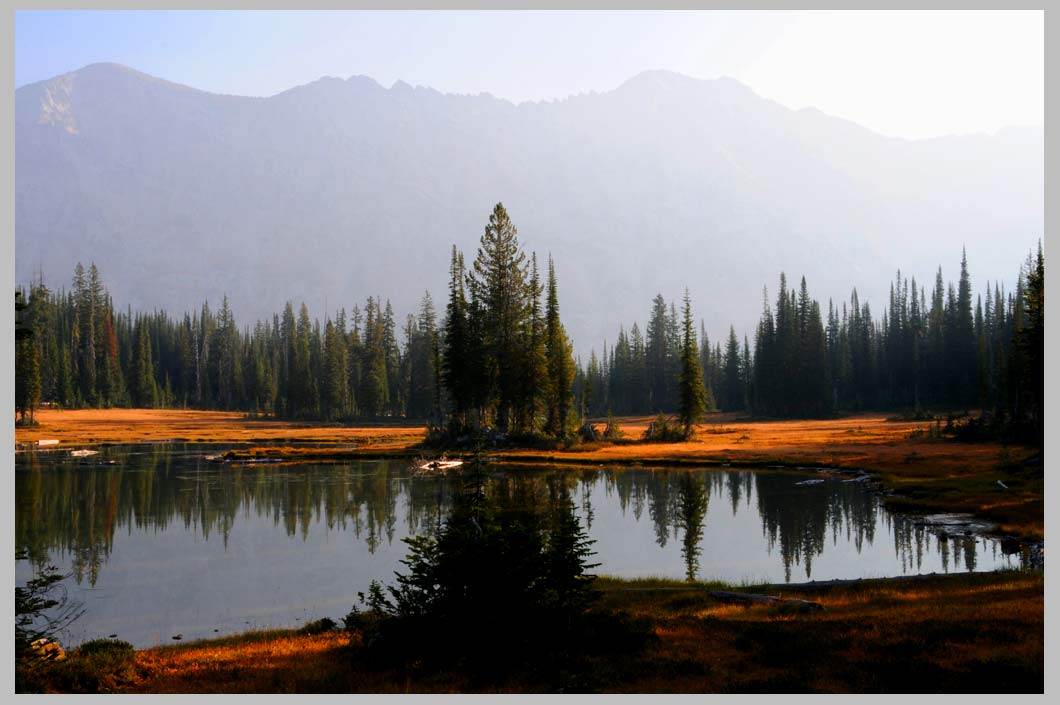
Hidden Lake, Fall Tableau. (X.5.2009) Eagle Cap Wilderness . . .
On the road in the American Northwest.

Hidden Lake, Fall Tableau. (X.5.2009) Eagle Cap Wilderness . . .
On the road in the American Northwest.
CREDOImages have become cheap.
Perhaps you've noticed just as I have that the typical
consumption of pictures has a more or less regular rhythm
to it. Much like the picking of berries from a bush, putting
them hungrily in our mouths as our hand reaches down
to grab still more, and sustaining the feast as long as the
bush yields, or hunger lasts, we have developed the habit
of "browsing" magazines and photobooks in much the
same way. The tempo of both types of browsing—berries
and images—is upon closer inspection remarkably similar,
about two beats or quarter notes in 2/4 time, metronome
marking 80 to 84. One, two; One, two; One, two, etc., etc.,
etc., with each repetition marking a flip of the page. Like
most human rhythm, this is most likely tied to the breath
cycle and heartbeat. (Clicking through images on the
internet is basically the same, although perhaps a bit
more limited or slower, depending on the speed of your
connection.)
As a musician, I find this interesting. I find it also disturbing.
In browsing berries, such feasts are rare. But not so with
contemporary images; they are everywhere, hitting us on
all sides. It would be interesting to know, on average, how
many still images a person of Western city-culture encounters
per day. It is almost certainly orders of magnitude more than
a wholesome visual diet might desire, or might be able to
accommodate.
So, for artists putting their whole soul into each image they
make, this is not good news. The problem for me is simple:
how to get the window or frame of each image out of the
world of mere consumption and back into the natural world
of very much slower contemplation. The latter, in my
experience at least, is tied not so much to browsing, but
rather to walking, and then on frequent, special occasions,
sitting. Sitting to let the scene, the object, the tableau, the
movement, speak to you. This is just like one might naturally
stop and sit and listen to what an interesting stranger
encountered on a path might have to say.
Perhaps this is why museums, which I have come to dislike
almost as much as I dislike the 2nd-hand decadence on display
in most classical music concert halls, still have something of
a role to play. First, we expect museums, like libraries, to be
silent. Second, we expect to walk from space to space—
certainly a more noble rhythm than mere page flipping. Third,
we expect to experience if not objects of truth and beauty, than
at least something which is artistically in some way meaningful,
or as the initiated say, "shocking and original." Admittedly, the
light, or the air, or the tap water, or the soundscape, won't quite
match what is offered in the mountains at any time and at
any season entirely for free, but at least it will allow us to exit—
if for however briefly—our everyday images-as-cheap-browse
habitual mode of perception.
IX.27.2009,
Heather Camp,
Eagle Cap Wilderness
| "CREDO" is a part of THE LITTLE CLAVIER—
631 pages w/ 120 b & white photographs | lower right full-screen preview |
